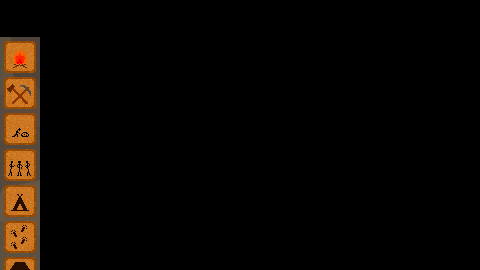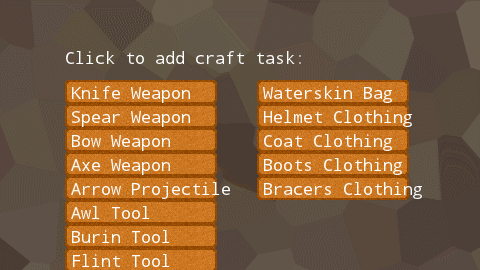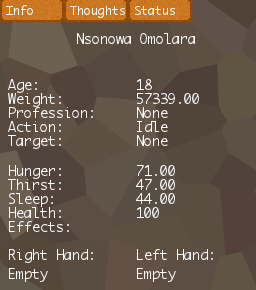New crafting system – Using the workshop to build things was getting too clunky and confusing, so I decided to overhaul it. Now there is a crafting screen instead of a workshop menu. From the crafting screen, you can see all available materials near the meeting point, all build-able items and a list of current crafting tasks. It’s much easier to see whether you have enough materials to make something. To go with the new crafting system there are also Work Areas you can assign. These are just patches of ground where you want your people to actually do the crafting. If you don’t assign any Work Areas, they will just choose a random spot on the ground. Also you can build a tool rack where people will store unused tools, although I haven’t done the sprite for it yet and it looks just like the food pit.

New aggression system – I forgot to mention this in the last update, all animals now run on a new aggression system. Previously animals would either run away or fight when faced with a threat, and would do the same thing every time. Now their decision can be influenced by different factors such as distance to threat and current health. This leads to more dynamic interactions between animals. For example a lion can start off ignoring a nearby mammoth. If the mammoth wanders close enough to be considered a threat, the lion charges at the mammoth. The mammoth might try run away at first, but if the lion gets too close, the mammoth decides to also charge at the lion. If the lion gets severely injured in the fight, it then changes its mind and starts running away. There are probably going to be weird edge cases with this new system that I’ll have to fix up as they appear.
Timeline – Surviving is nice and all, but I felt like there was no sense of progression in the game. To help keep track of the efforts of your people, I created a timeline that records any notable actions or events that happened each day. The timeline can be accessed under the “Tribe” management screen.

Brains remember after saving – This one took a while to implement, I’ve been putting it off hoping it wouldn’t become an issue. Basically every time you loaded a game in the Alpha 2 version, none of the animals/humanoids would remember what they were doing and would recalculate their motives from scratch. Well the AI got too complicated for that, so now everyone remembers everything they were doing before the game was loaded.
Annual migration – On top of the usual animals wandering on and off the map, there is now also an annual migration that occurs during Autumn. Large numbers of certain animals will travel from one side of the map to the opposite side during this period (currently using Buffalo but that can easily be changed).
Snow and Ice – Snow and ice are able to form/melt based on temperature and weather rather than based on season. If your people get thirsty during Winter but all the water has frozen over, set a tree on fire and watch what happens to the nearby ice.

Other minor changes – Animals produce more materials when butchered, UI tweaks, tutorial changes, camera zooming and lots of bug fixes




























